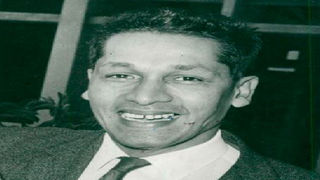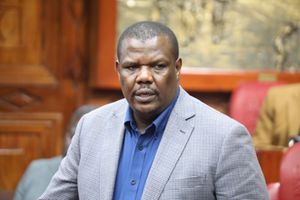
Pio Gama Pinto.
| File | Nation Media GroupWeekly Review
Premium
Kisilu Mutua, CIA and the secrets of Pio Gama Pinto’s murder
When Kisilu Mutua was buried in a low-key ceremony on September 15, 2023, the internment was the final farewell to the fall guy in the 1965 murder of Pio Gama Pinto – the symbol of leftist politics in Kenya.
Like many leftist politicos who challenged Western capitalism, Pinto was a marked man. To think that a handcart pusher and vegetable vendor was the man behind the assassination was the lowest that our detectives went to cover up what was political in high-stakes Cold War games.
Kisilu died twice: By being jailed for a murder that he never planned, and after the government failed to pay his compensation of Sh2.5 million awarded as general damages by Justice John Mativo in 2017.
It is still a scandal that Kisilu died destitute after the government appealed this award. Kisilu was 22 (some records say 18) when he was jailed. He then spent 36 years in Kamiti Maximum Security and Naivasha Prisons until he was released on July 4, 2001, following orders of the late President Daniel arap Moi.
When he died, he was a bitter man. He had been tossed from different government offices looking for justice. Those who wanted Pinto dead had prepared space for a fall guy. Kisilu told the High Court that he had been asked to scare a certain Asian by a man he only knew as Sammy.
It was the second time he had been asked to carry out such a task, only that this time it turned fatal. He claimed that Sammy and Chege Thuo, his co-accused, were Special Branch agents. He was naïve, perhaps young to comprehend.
Pinto’s murder
Till now, the identity of “Sammy” has never been revealed, and Justice John Ainley felt that the police were not keen to fish out the prime suspects: “The case for the republic is that three men were present and that three men ran away from the scene of Pinto’s murder. Yet, it has been asked, why has the police not demonstrated its truth through further investigation?
How about the man, Sammy, who is mentioned in the statement, the man who is said in the statement to be the prime mover in the whole affair, and the taxi driver, Charles? Why was the blue Fiat not traced? We may not have all who were involved in the crime before us.”
Six months earlier, the CIA had filed a secret document titled “Leftist Activity in Kenya”, in which they named Oginga Odinga as the country’s prime mover of anti-Western campaign and Pinto as the “close associate”. As a journalist, Pinto’s hand was seen in the infiltration of the Soviets in the Kenyan media.
“The Soviets appear to be making a major effort to gain a grip on Kenyan news media and Oneko’s Information ministry… an extreme left-wing Goan journalist P. G. Pinto, long resident in Kenya – is a close associate of Odinga and Oneko, and appears to be lurking in the background of (KNA) Kenya News Agency as well as engaging in clandestine political activity on their behalf.” In the secret document, the CIA reported that “the editor of KNA, ‘considered politically reliable by Odinga and Oneko’, lives in Pinto’s house, and Pinto’s wife is Oneko’s secretary”.
In his book Reds and Blacks, former US ambassador William Atwood described Pinto as “Odinga’s number one braintruster… principal liaison man with Communist embassies as well as his chief political adviser.” Even Atwood did not seem to agree that a vegetable vendor would have a motive to kill Gam Pinto. “Although two men were later arrested and jailed for the murder, it was never satisfactorily explained.
Some said that Pinto was killed because he was going to tell Kenyatta about a plot to overthrow him; others suspected that some activist Kikuyus – with or without Kenya’s tacit approval – decided to deprive Odinga of his services.” Atwood argued that “Pinto knew too much, and a lot of politicians had reason to want him silenced”.
According to Atwood, the man who lost most was Odinga, who had lost his principal advisor: “Odinga sorely missed his guidance and counsel, as he demonstrated by committing blunder after blunder in the months that followed.” Whether Pinto’s death was designed to end the Communist infiltration in Kenya is not clear. That morning, Pinto had left his house in Nairobi’s Lower Kabete Road before 8am to take his wife to work and one of the three children to school.
Little girl
“He came back to the house shortly before 9am and drove his car to the back of the house,” said Margaret Kabicho, the house manager. “After a short while he went out to his car with his youngest child, put the little girl at the back of the car and drove off to the corner of the house down the drive. It was his habit to give the little girl a lift to the end of the drive. It was my duty to go and collect her at the driveway entrance.”
Kabicho had followed Pinto’s car to the gate when she heard somebody greet Pinto, Jambo bwana. “The voice came from behind the hedge on the right side of the drive, but I was not able to see anyone. I then heard three shots and saw smoke coming from the right side of the hedge.”
Pinto was dead. It was Mutua who would be arrested later on as the man on the scene. Mutua had denied that he led the Criminal Investigation Department (CID) officers to the crime scene and claimed in court that he was tortured to confess to Chief Inspector Robert Shaw.
Another line of evidence that was not followed was that the men were sent by a certain Makanyengo to “frighten” Pinto “because he had interfered with his union”. That also could be a narrative by the killers.
The larger picture of the plot seems to have been lost in the trial. One of Pinto’s employees, Waweru Nganga, had told the court that Pinto feared for his life. He said he had a conversation with Pinto on February 23 after he hosted two visitors, a Mr Sugi and a Mr Njenga: “Mr Pinto told me to watch Njenga closely whenever he came there, because he (Pinto) thought there were some people who had offered Njenga money to kill him, Kaggia and Kali. That was all he said.” It is not clear whether the said Mr. Njenga was the same man later convicted of killing Cabinet minister Tom Mboya in 1969 or it was a different Njenga.
Mau Mau sympathiser
What we know about Pio Gama Pinto is that he was a socialist, and at the height of the emergency, he was detained for being a Mau Mau sympathiser and was instrumental in searching for guns for the movement. The intelligence had Pinto detained first in Fort Jesus Prison and then to Takwa in Manda Island, reserved for the radicals.
He was later taken to restriction in Kabarnet, where his wife Emma was allowed to join him in 1959. It was in this restriction in Kabarnet that their first child, Linda, was conceived. In October 1959, Pio was declared a non-threat to security and released just in time for the birth of their second daughter, Malusha.
From an office at the Desai Memorial Hall, then located near Nairobi fire station, Pinto wrote many petitions and articles lambasting the colonial government for brutality against the freedom fighters. He also called for releasing Jomo Kenyatta and fund-raised money to hire lawyers for the detainees.
The only other Asian detainee was Makhan Singh, the unionist, who had been detained in 1950 on the orders of Governor Philip Mitchell and for an indefinite period. He was released on October 20 1961 after eleven years of confinement without any charge or trial.
Thus, Pinto played in the top league of leftists in Kenya, and it was baffling that a vegetable vendor became the man accused of his murder. Many people believe that Pinto’s death was part of attempts to reconfigure Kenyan politics. His death changed the matrix.
Kisilu Mutua was only used by the killers as the fall guy. They then vanished into thin air. The man who pulled the trigger was never found – neither were we told why Pinto was killed.
After 36 years in jail, and when the matter was forgotten, Kisilu Mutua was set free. He died a very bitter man.
[email protected], Twitter: @johnkamau1





